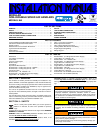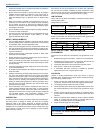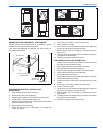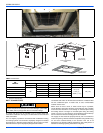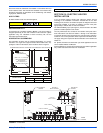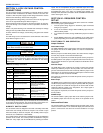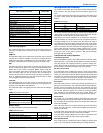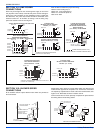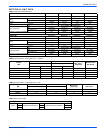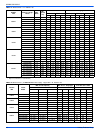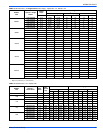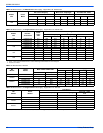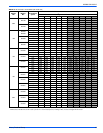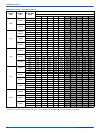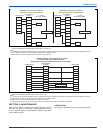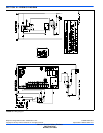
819288-UIM-A-0212
6 Unitary Products Group
SECTION V: LOW VOLTAGE CONTROL
CONNECTIONS
The 24 volt power supply is provided by an internally wired low voltage
transformer which is standard on all models, However, if the unit is con-
nected to a 208 volt power supply, the low voltage transformer must be
rewired to the 208 volt tap. See the unit wiring label.
Field supplied low voltage wiring can exit the unit on the top right hand
corner or the right hand side panel. Refer to Figure 3.
Remove desired knockout and pierce foil faced insulation to allow wir-
ing to pass through. Use as small of a hole as possible to minimize air
leakage.
Install a 7/8” plastic bushing in the selected hole and keep low voltage
wiring as short as possible inside the control box.
To further minimize air leakage, seal the wiring entry point at the outside
of the unit.
The field wiring is to be connected at the screw terminals of the control
board. Refer to Figures 10 & 11.
The low voltage connections may be connected to the screw terminals
or the quick connect terminals. The screw terminals and the quick con-
nect terminals are physically connected on the control board.
HUMIDITY SWITCH INPUT
The air handler control is designed to work with a humidity control that
closes when the humidity is below the set-point. The control is open
when the humidity is above the set-point. This humidity control may be
referred to as a humidistat or a dehumidistat.
The humidity switch controls both humidification and de-humidification
operation of the control. The control provides humidification using the
HUM OUT relay output and de-humidification by lowering the blower
speed. This is accomplished using the LOW FAN output and a field
installed two-speed fan relay kit for non-variable speed models and the
de-humidification input of the motor for variable speed models. The
humidity switch should be connected to the R and HUM terminals of the
control. See Figures 10 & 11.
SECTION VI: REQUIRED CONTROL
SET-UP
IMPORTANT: The following steps must be taken at the time of installa-
tion to insure proper system operation.
1. Consult system wiring diagram to determine proper thermostat
wiring for your system.
2. If heat kit is installed, change HEAT ENABLE jumper from NO
HEAT to HEAT position.
3. If a humidstat is installed, change HUM STAT jumper from NO to
YES.
4. Set the MODE jumper to A/C (Air Conditioner) or HP (Heat Pump)
position depending on the outdoor unit included with the system.
FUNCTIONALITY AND OPERATION
Jumper Positions
Heat Enable Jumper
The HEAT ENABLE jumper configures the control for heat kit operation.
The jumper must be in the HEAT position if a heat kit is installed with
the air handler.
With the jumper in the NO HEAT position, the control will not energize
the heat relay outputs or sense the limit switch input.
If the jumper is not present, the control will operate as if the jumper is in
the HEAT position. If the jumper is not present and a heat kit is not pres-
ent, the control will sense an open limit condition and the blower will run
continuously.
Hum Stat Jumper
The HUM STAT jumper configures the control to monitor the humidity
switch input. With the jumper in the NO position, the control will ener-
gize the HUM terminal with 24 VAC continually. With the jumper in the
YES position, the control will monitor the HUM input to control the HUM
OUT output to control an external humidifier.
If the jumper is not present, the control will operate as if the jumper is in
the YES position.
Mode Jumper
The MODE jumper configures the control to operate properly with an air
conditioner (AC position) or heat pump (HP position). With the jumper in
the AC position, the control will energize the O terminal with 24 VAC
continually. With the jumper in the HP position, the O input signal is
received from the room thermostat.
If the jumper is not present, the control will operate as if the jumper is in
the HP position.
SPARE Jumper
The control includes a spare jumper that can be used if a jumper is lost.
The SPARE jumper does not have any effect on the operation of the
control.
Status and Fault Codes
The control includes an LED that displays status and fault codes. These
codes are shown in Table 3. The control will display the fault codes until
power is removed from the control or the fault condition is no longer
present.
All wiring must comply with local and national electrical code require-
ments. Read and heed all unit caution labels.
It is possible to vary the amount of electric heat turned on during the
defrost cycle of a heat pump. Standard wiring will only bring on the
first stage of electric heat during defrost. See Heat Output and Limit
Connections and Table 6 for additional information on heat during
defrost cycle.
TABLE 2:
Low Voltage Connections
Terminal Signal Comment
R 24 VAC power (fused)
G Continuous Fan operation
Y/Y2
Second or full stage
compressor operation
Y1
First stage compressor
operation
Not used with outdoor units
having one stage compressors.
W2 Second stage heat operation
W1 First stage heat operation
O Reversing valve operation
24 VAC will be present at this
terminal when the MODE
jumper is in the AC position.
This is normal.
HUM Humidity switch input
24 VAC will be present at this
terminal when the HUM STAT
jumper is in the NO position.
This is normal.
X/L
Connection point for
heat pump fault indicator
This terminal is a connection
point only and does not affect
air handler control operation.
COM 24 VAC common
NOTICE
NOTICE



